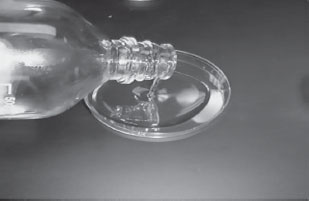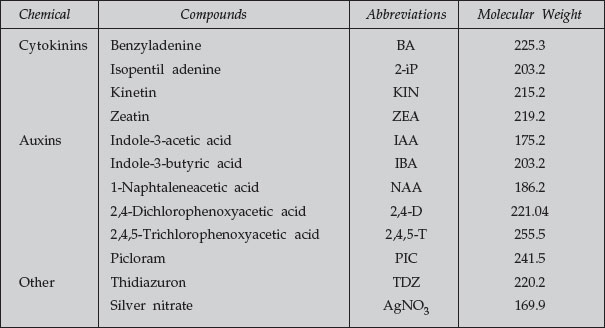Media for Plant Tissue Culture
Fertilizer Stock Mix
- ½ tablespoon all-purpose 18:18:18 (N.P.K.) water-soluble fertilizer
- 2 cups of water
- Gently boil to dissolve all ingredients and store in the refrigerator
 |
| Figure 13 |
Basic Nutrient Mix
The purpose of agar in growth media is solely to support the tissue. Instead of agar, use sand to support the culture.
- 2 cups of distilled water
- Between 2 tablespoonfuls and ¼ cup of sugar
- ½ tablespoon of fertilizer stock
- ½ Inositol tablet (500 mg)
- ½ vitamin tablet with thiamine
- Gently boil to dissolve all ingredients and store in the refrigerator
- ½ teaspoon of malt
- Add basic nutrient mix to make 2 cups
- Check the pH using narrow-range pH indicator tape
- Adjust pH to between 5 and 6 with vinegar or sodium bicarbonate
- Add several drops of yellow food coloring to identify the formula
- Gently boil to dissolve all ingredients and cool
- Cover and put in the glove box
- Add 100 mg silver nitrate
- Pour into sterile jars and cap
- Store in the refrigerator until use
- ¼ to ½ cup of coconut milk
- Add basic nutrient mix to make 2 cups
- Check the pH using narrow-range pH indicator tape
- Adjust pH to between 5 and 6 with vinegar or sodium bicarbonate
- Add several drops of red food coloring to identify the formula
- Gently boil to dissolve all ingredients and cool
- Cover and put in the glove box
- Add 100 mg silver nitrate
- Pour into sterile jars and cap
- Store in the refrigerator until use
- (Optional) ½ teaspoon of malt
- Add basic nutrient mix to make 2 cups
- Add several drops of blue food coloring to identify the formula
- Sterilize and cool to around 55°C
- Cover and put in the glove box
- Stir in ½ teaspoon peroxide
- Add 100 mg silver nitrate
- Pour into sterile jars and cap
- Store in the refrigerator until use
The purpose of agar in growth media is solely to support the tissue. Instead of agar, use sand to support the culture.
- Boil sand in water on your stovetop.
- Store the clean sand in a plastic bag.
- Put 1 ounce of sand (volume) in a baby food jar.
- Sterilize jars in your pressure cooker.
- Place sterilized jars, prepared caps, and sterile media solution in your glove box.
- In the glove box, add enough sterile media solution to just saturate but not cover the sand.
- Close the jar with a prepared cap.
- Store in the refrigerator until use.
Note: Do not microwave the sand, it will splatter all over.
The following are bacterial or fungal agars, use them for ideas.
- 40 grams amaranth flour
- 40 grams soy flour
- 19 grams agar
- 1 liter distilled water
- 20 grams amaranth flour
- 20 gm brown rice flour
- 20 gm potato flour
- 20 gm soy flour
- 4 gm malted barley
- 19 gm agar
- 1 liter distilled water
- 50 gm yellow cornmeal
- 5 gm dextrose
- 19 gm agar
- 1 liter distilled water
- 40 gm barley flour
- 2 gm malt extract
- 1–2 gm yeast extract (optional)
- 9.5 gm agar
- 500 liter distilled water
- 20 gm dried dog food
- 20 gm amaranth flour
- 4 gm dextrose or malt extract
- 1 liter distilled water
- 30 gm malt extract
- 2 gm soya peptone
- 15 gm agar
- 1 liter distilled water
- Adjust pH to 5.6. Sterilize for 16 min.
- 20 gm of agar
- 20 gm of malt extract
- 2 gm of yeast
- Water to 1 liter
- 20 gm of agar
- The strained broth produced by boiling 300 grams of diced potatoes in 1 liter of water for 1 hour
- 10 grams of dextrose
- Clean water back up to 1-L volume In one experiment, tapioca starch produced the greatest number of shoots and nodes.
 |




